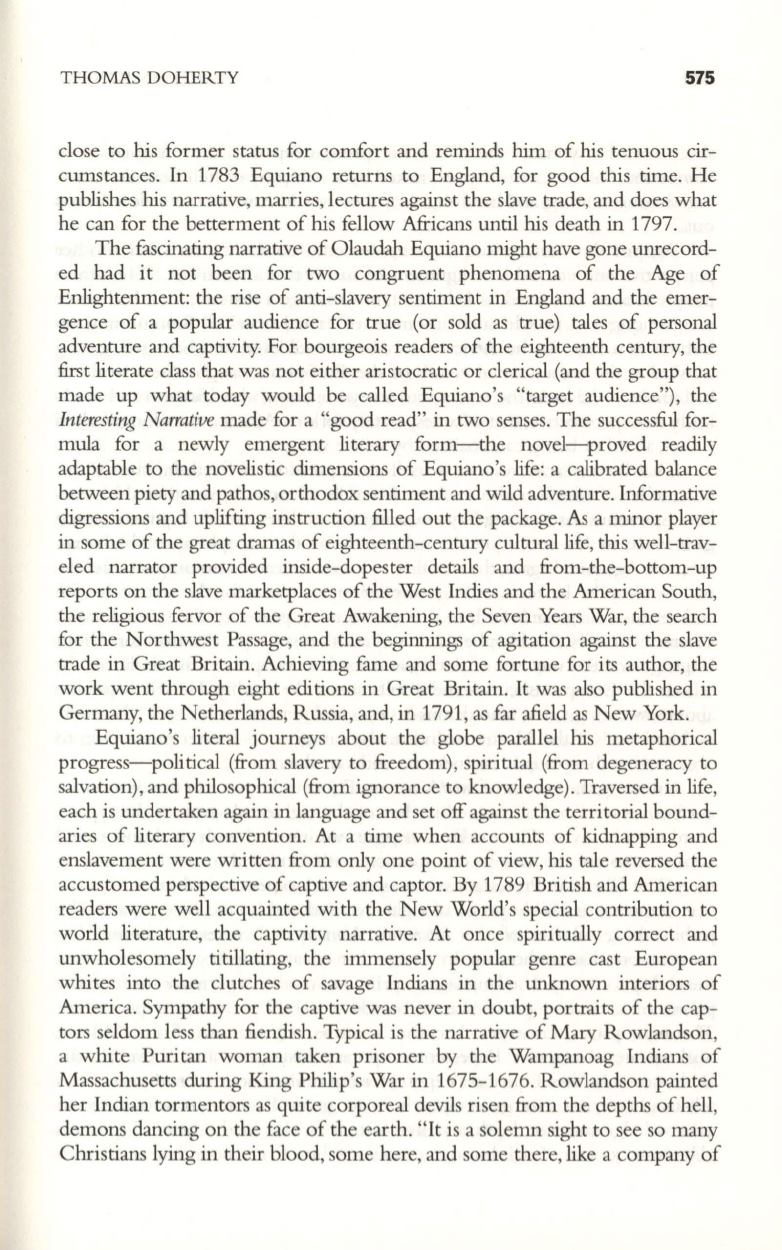
THOMAS DOHERTY
575
close to his former status for comfort and reminds
him
of his tenuous cir–
cumstances. In 1783 Equiano returns to England, for good this time. He
publishes his narrative, marries, lectures against the slave trade, and does what
he can for the betterment of his fellow Africans until his death in 1797.
The fascinating narrative of Olaudah Equiano might have gone unrecord–
ed had it not been for two congruent phenomena of the Age of
Enlightenment: the rise of anti-slavery sentiment in England and the emer–
gence of a popular audience for true (or sold as true) tales of personal
adventure and captivity. For bourgeois readers of the eighteenth century, the
first literate class that was not either aristocratic or clerical (and the group that
made up what today would be called Equiano's "target audience"), the
Interesting Narrative
made for a "good read" in two senses. The successful for–
mula for a newly emergent literary form-the novel-proved readily
adaptable to the novelistic dimensions of Equiano's life: a calibrated balance
between piety and pathos, orthodox sentiment and wild adventure. Informative
digressions and uplifting instruction filled out the package.
As
a minor player
in some of the great
dramas
of eighteenth-century cultural life, this well- trav–
eled narrator provided inside-dopester details and from-the-bottom-up
reports on the slave marketplaces of the West Indies and the American South,
the religious fervor of the Great Awakening, the Seven Years War, the search
for the Northwest Passage, and the beginnings of agitation against the slave
trade in Great Britain. Achieving fame and some fortune for its author, the
work went through eight editions in Great Britain. It was also published in
Germany, the Netherlands, Russia, and, in 1791, as far afield as New York.
Equiano's literal journeys about the globe parallel his metaphorical
progress-political (from slavery to freedom), spiritual (from degeneracy to
salvation), and philosophical (from ignorance to knowledge). Traversed in life,
each is undertaken again in language and set off agains t the territorial bound–
aries of literary convention. At a time when accounts of kidnapping and
enslavement were written from only one point of view, his tale reversed the
accustomed perspective of captive and captor. By 1789 British and American
readers were well acquainted with the New World's special contribution to
world literature, the captivity narrative. At once spiritually correct and
unwholesomely titillating, the irnrnensely popular genre cast European
whites into the clutches of savage Indians in the unknown interiors of
America. Sympathy for the captive was never in doubt, portraits of the cap–
tors seldom less than fiendish. Typical is the narrative of Mary Rowlandson,
a white Puritan woman taken prisoner by the Wampanoag Indians of
Massachusetts during King Philip's War in 1675-1676. Rowlandson painted
her Indian tormentors as quite corporeal devils risen from the depths of hell,
demons dancing on the face of the earth. "It is a solemn sight to see so many
Christians lying in their blood, some here, and some there, like a company of


